
Ultimate Butter Cake or UBC
Recipe by Sarah Phillips © 2003 Sarah Phillips CraftyBaking.com
Variations: Ultimate Chocolate Butter Cake or UCBC and Variations; Ultimate Buttery Streusel Crumb Coffee Cake and Variations; Ultimate Cinnamon Crunch Coffee Cake; Ultimate Coconut Butter Cake or UCOBC; Ultimate Egg Nog Butter Cake or UENBC; Ultimate Fresh Strawberry Butter Cake or UFSBC; Ultimate Peanut Butter Cake or UPBC; Ultimate Pistachio Butter Cake or UPBC; Ultimate Rum Butter Cake or URBC; Ultimate White Chocolate Butter Cake or UWCBC


Recipe used with the Nutella Raspberry Bliss Cake
I created the Ultimate Butter Cake (buttercake) to be a rich, moist and tender treat because I was tired of eating dry, flavorless cakes. It has a fine to medium crumb in texture and is somewhat dense, but much lighter than a pound cake. Many brides have selected this for use in a wedding cake because it can be made in so many flavors (and is quite flavorful) and doesn't need a lot of trimming. It can be easily filled and frosted with many types of recipes and decorated or served plain with fruit. It's now my family's favorite all-occasion cake!
CAKE RECIPE HELP

Cupcakes and photo by odetteganda, Premium Member © Sarah Phillips
I use ingredients right from the refrigerator when I bake most of my recipes, except with chocolate from the freezer, because I have found that the friction from the beaters quickly warms them. I believe that the step of using room temperature ingredients in a recipe makes them too warm, and is old-fashioned, necessary when cakes were mixed by hand. I do not see a difference on how recipes come out when using ingredients cold, right from the refrigerator, when using electric mixers of today.
INGREDIENTS
unbleached all purpose flour: 4 cups; spoon into measuring cup and level to rim / 17.64 ounces / 500.09 grams; do NOT use King Arthur flour (it's too high in gluten, use Gold Medal or Pillsbury)
baking powder: 1 tablespoon (3 teaspoons) / 14.7 grams
salt: 1 teaspoon / 6 grams
whole or 2% milk: 1 1/2 liquid cups / 12.75 ounces / 363 grams; use cold - does not have to be at room temperature
vanilla extract: 1 tablespoon (3 teaspoons) / 12 grams
almond extract (optional): 1/2 teaspoon / 2 grams
OR 1 teaspoon orange or lemon extract or 1 tablespoon grated orange peel or 1 to 2 teaspoons lemon peel or 1/4 teaspoon citrus oil
unsalted butter: 2 cups (4 sticks) / 1 pound / 452 grams; use cold - does not have to be at room temperature
sugar or superfine sugar: 2 cups / 14 ounces / 400 grams
eggs, cracked: 3 large / 5.25 ounces / 150 grams; use cold; does not have to be at room temperature
NOTE: Cake is mixed using a KitchenAid Professional 600 Series Mixer, 575 watts. Any mixer used that is less powerful will result in unexpected results.
INSTRUCTIONS
Prepare the oven and baking pans:
1. Position the oven shelf in the middle of the oven. Preheat the oven to 350 degrees F.
2. Spray two 9-inch, preferably light colored, heavy NOT nonstick pans with nonstick cooking oil. (If you use dark, nonstick baking pans or ovenproof, Pyrex glass pans, be sure to reduce the oven heat by 25 degrees F, but the recipe will not bake as well in these types of pans; it will result in crusty, dark edges.)
SARAH SAYS: Instead, you can line each greased baking pan with a greased piece of parchment paper. Here's how:
Place one pan on top of a piece of parchment paper and trace around it with a pencil. The lead is nontoxic.
Cut out the round of parchment paper following the pencil marks as a guide.
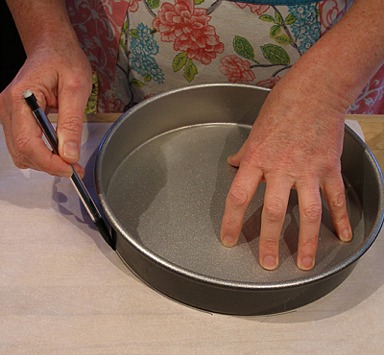
Spray the baking pan with nonstick cooking oil.
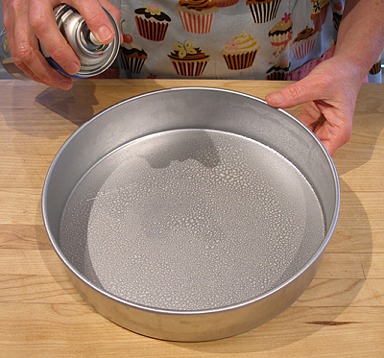
Place the parchment round in the bottom of the pan.

Spray the top of the parchment round with nonstick cooking oil.

Repeat the process with the other pan. Set the two pans aside.
Make the cake batter:
1. In a medium bowl, after measuring, sift together the flour, baking powder, and salt; set aside.
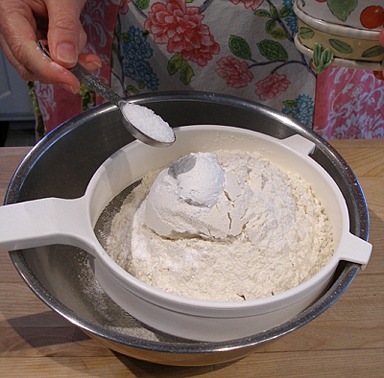
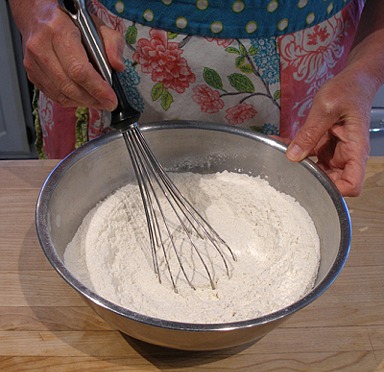
2. Add the vanilla to the milk and set aside.
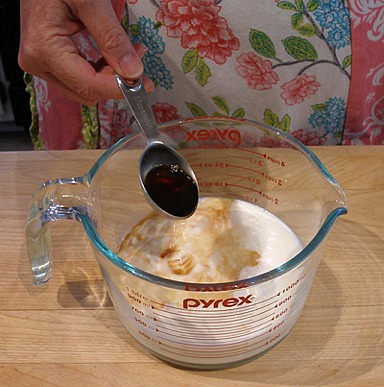
3. Beat the butter in the bowl of a stand mixer, fitted with a paddle attachment, on low until softened. (If the butter is cold, it will warm quickly from the beaters - taking about 60 seconds).
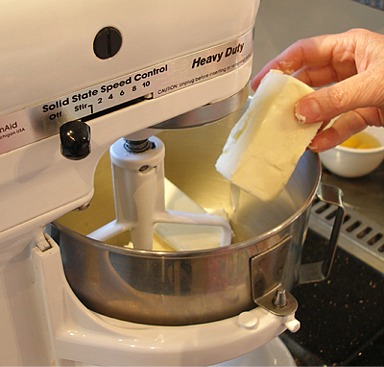
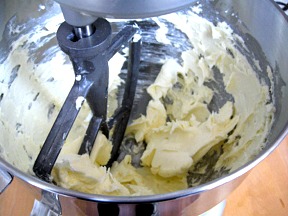
4. Add the sugar in a steady stream at the side of the bowl.
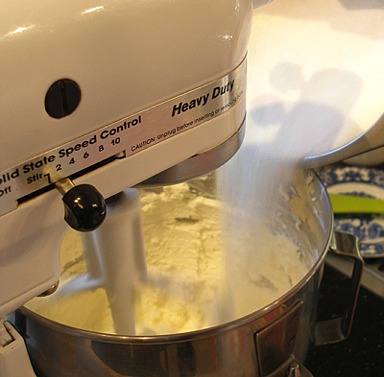
Increase speed to medium and beat for 1 minute until the butter is lighter in color and aerated.
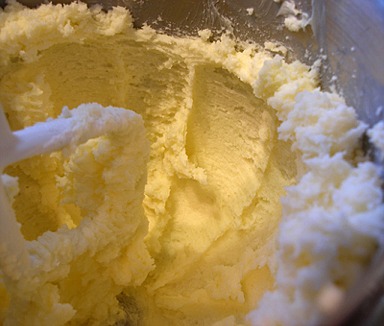
SARAH SAYS: Another way to tell when the mixture is aerated properly, is when there are ridges of butter and sugar left at the side of the bowl as the beater moves through it.
The butter is tacky and not too soft and has not melted.
5. Stop the mixer and scrape the side and bottom of the bowl with a large rubber spatula.
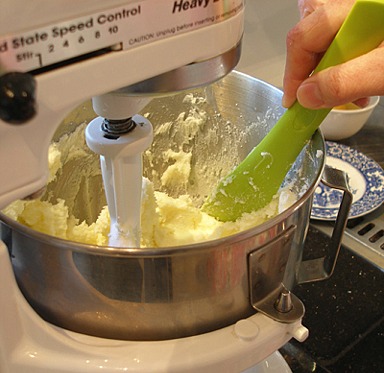
6. With the mixer on low, add the eggs one at a time and beat for 20 seconds after each addition.
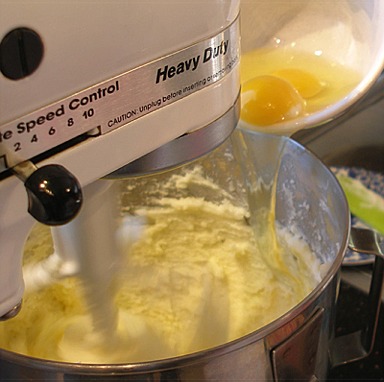
After the eggs have been added, increase the mixer speed to medium and beat the mixture for 2 minutes. (If the eggs are cold, the batter will curdle slightly. It's ok. It will come together as the batter warms from the beaters. ) Set the kitchen timer to help you keep track of the time. The mixture will become fluffy and aerated.

SARAH SAYS: The butter and eggs are an excellent temperature. Notice that it forms ridges on the side of the mixing bowl after the beaters pull through the mixture; the batter is tacky and not too warm so it sticks to the side of the mixing bowl! The batter has become lighter in color as it takes on air bubbles and SOMEWHAT fluffy, as well!
7. With the mixer on LOW speed, add the flour mixture in 3 equal portions, alternating with the milk in 2 equal portions, beginning and ending with the flour. (If the milk is cold, the batter will curdle slightly. It's ok. It will come together when you add the flour.)
Add the flour and liquid ingredients in increments quickly; do NOT wait in between additions too long as you don't want to overmix the batter.

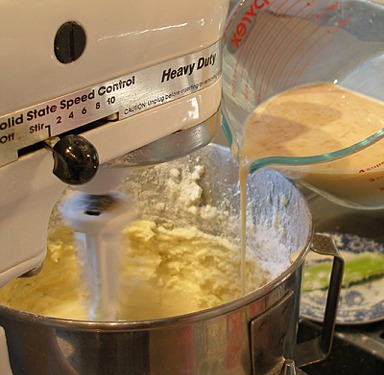
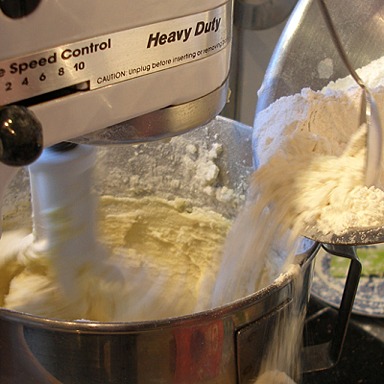
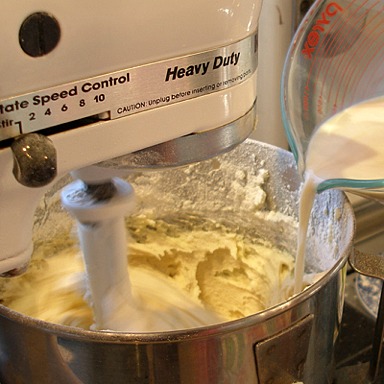
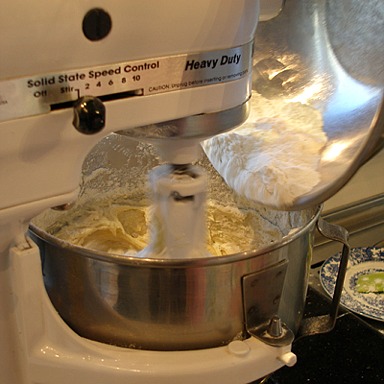
8. After completing the last addition of flour, stop the mixer, and scrape the side and bottom of the bowl with a large rubber spatula.
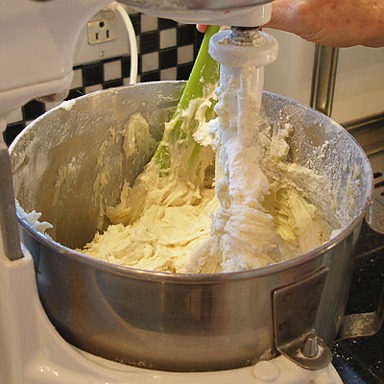
Then, let the mixer run for 30 seconds on LOW. The batter will be very thick and form ridges on the side of the bowl as the beater pulls through the batter. STOP the mixer. Do NOT overmix.
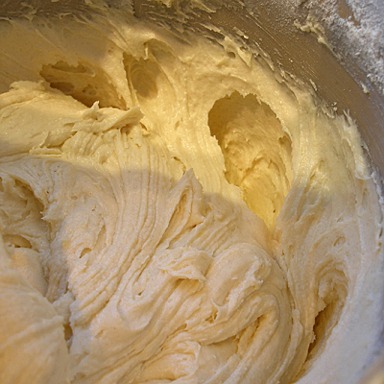
9. Remove the mixing bowl from the mixer. With a large rubber spatula, give the batter ONE or TWO quick folds to incorporate any stray flour or milk left at the sides and bottom of the bowl. Then, STOP!

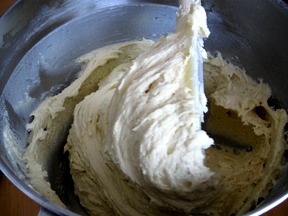

Divide the batter in the prepared baking pans (should fill 1/2 full) and lightly smooth the tops.

10. Bake for 40 to 45 minutes or until the top feels firm and gives slightly when touched and will shrink slightly from the side of the pan.
The cake will be slightly browned. If you insert a toothpick in the middle and remove, there should be a few moist crumbs attached, but not batter.
The cakes will have a slight dome and small cracks on top right when it comes from the oven, but as the cakes cool, they will flatten on top and the tiny cracks will disappear.

NOTE: The cake can be baked in a 9 x 13 x 2-inch, greased cake pan, taking 45 - 55 minutes to bake. Cupcakes take 20 - 30 minutes to bake.
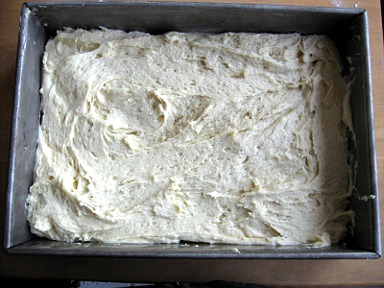
11. Remove cakes to cool on wire racks for 10 to 15 minutes. Loosen the sides with a small metal spatula or sharp knife, taking care not to scratch the cake pan.
Invert onto cake rack and place upright to cool completely. Be careful, the cakes are delicate when warm.
The cake layers need no trimming before stacking because they cool flat.
STORAGE
The cake layers store nicely. They can be stored at room temperature for about 3 or more days. The cake layers freeze well for about a month or more. Keep well wrapped.

Photo and cake by sugarpie, Premium Member © Sarah Phillips Cake frosted and filled with Tami’s or Perfect Buttercream
ONE, 9 x 2-inch ULTIMATE BUTTER CAKE LAYER
Cut the above mixing times in about 1/3.
INGREDIENTS
2 cups unbleached all purpose flour -- spoon into measuring cup and level to top
1 1/2 teaspoons baking powder
1/2 teaspoon salt
3/4 cups whole or 2% milk (use cold; does not have to be at room temperature)
2 teaspoons vanilla extract with 1/4 teaspoon almond extract or 1/2 teaspoon orange or lemon extract or 2 teaspoons grated orange or 1 teaspoons lemon peel or 1/4 teaspoon citrus oil
1 cup (2 sticks / 226 grams) unsalted butter (use cold; does not have to be at room temperature )
1 cup sugar -- or superfine sugar
1 1/2 large eggs* (1 large egg plus 2 tablespoons of a lightly beaten egg) -- (use cold; does not have to be at room temperature )
*QUESTION: How do I halve one large egg?
SARAH SAYS: To halve 1 large egg, whisk it in a small bowl. Let the bubbles subside. Measure 2 tablespoons. Save the rest in the refrigerator and toss later in an omelet or scrambled eggs!
Follow the mixing instructions for the 2, 9-inch layers, above. Bake at 350 degrees F for 40 minutes.
VARIATIONS
Ultimate Chocolate Butter Cake or UCBC and Variations
Ultimate Buttery Streusel Crumb Coffee Cake and Variations
Ultimate Cinnamon Crunch Coffee Cake
Ultimate Coconut Butter Cake or UCOBC
Ultimate Egg Nog Butter Cake or UENBC
Ultimate Fresh Strawberry Butter Cake or UFSBC
Ultimate Peanut Butter Cake or UPBC
Ultimate Pistachio Butter Cake or UPBC
Ultimate Rum Butter Cake or URBC
Ultimate White Chocolate Butter Cake or UWCBC
Other Recipes
Rao’s Restaurant Meatballs
7464 views| 0 comments
White Chocolate Brownies
6366 views| 4 comments
Naturally Dyed Easter Eggs
11254 views| 0 comments










